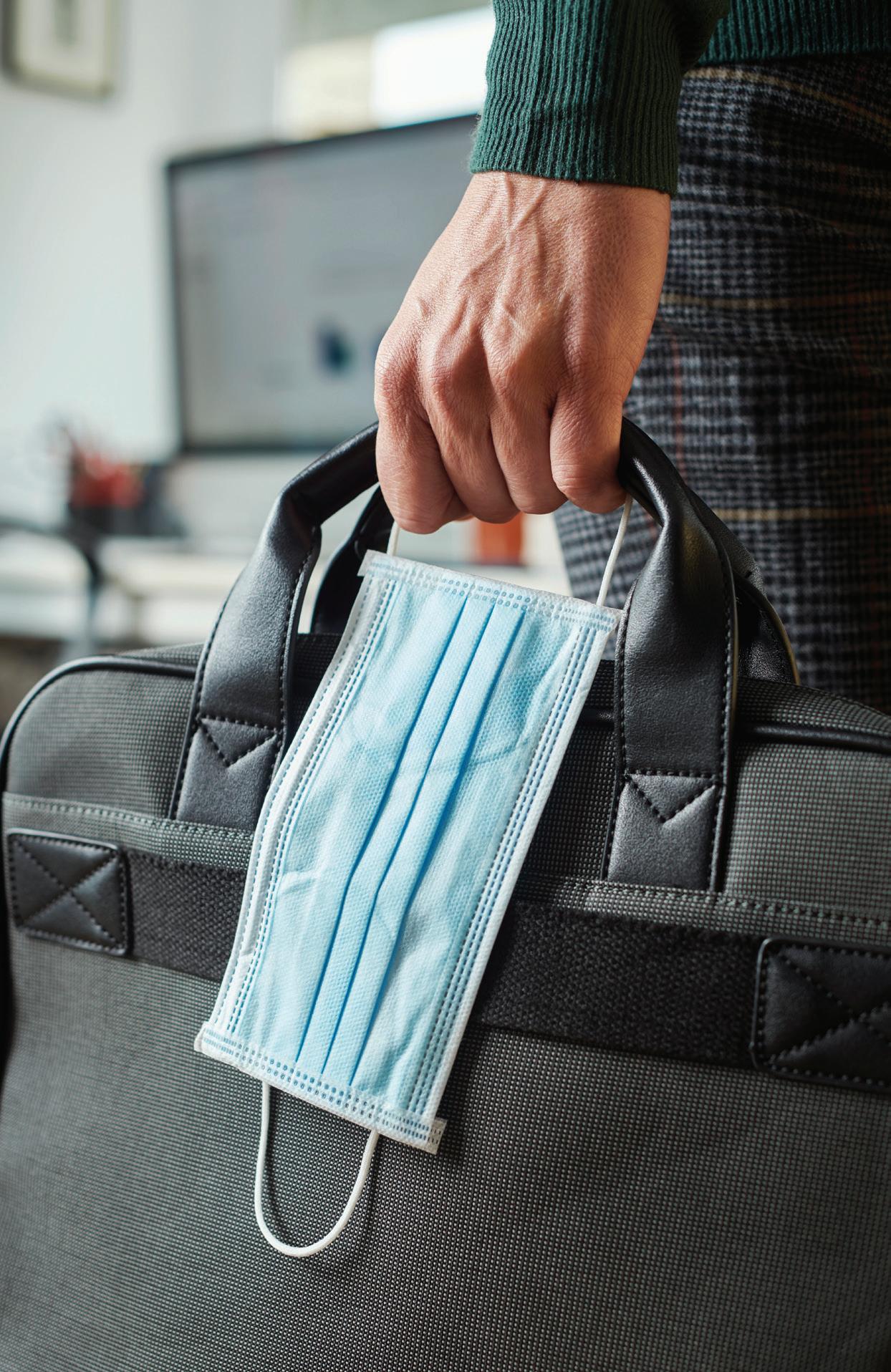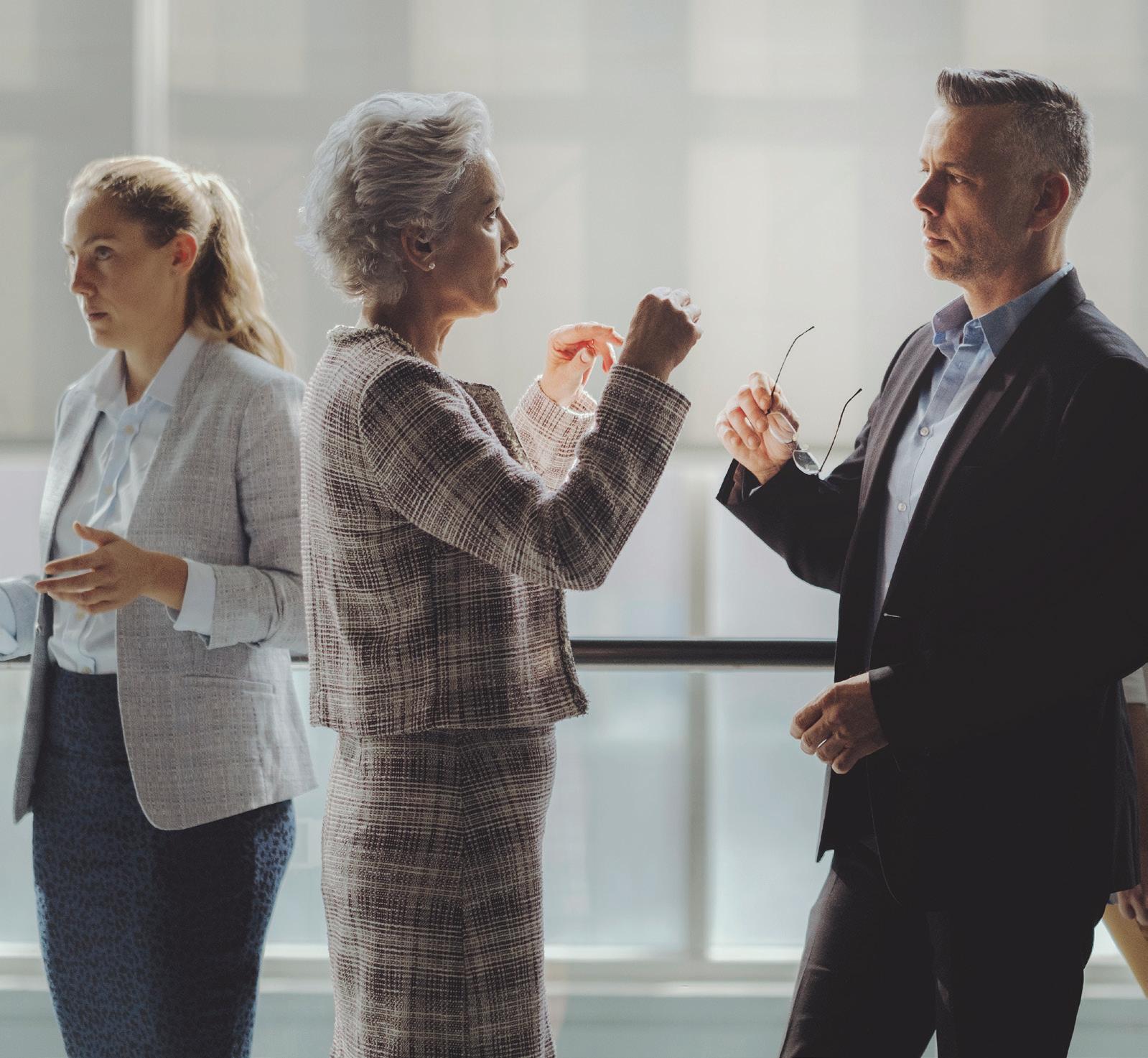
14 minute read
Ready? Dressed? Returning? Work as What You Do v. Where You Do It
Ready? Dressed? Returning? Work as What You Do v. Where You Do It
BY NATALIE ROONEY
Some people would like to work from home forever. Others never stopped working at the office. And others are ready to get back to the peace and quiet of their office routine. COCPA members share their organizations’ plans for work as they continue to navigate the ever-changing COVID-19 landscape.
On March 9, 2020, SM Energy’s emergency management team first met to monitor the rapidly developing COVID-19 pandemic. By March 11, the team was ready to test remote work, but the situation evolved so quickly, all office-based personnel began working from home on March 16. It’s remained that way ever since, says SM Energy Controller Pat Lytle, CPA, CGMA. ACM LLP* employees made a seamless transition to remote work, says CFO Kristin Holthus, CPA. It was a change for tax teams, but auditors already were used to working off-site. ACM’s IT team set up everyone and addressed a few connectivity issues. Holthus says she has been impressed with how well everyone has maintained productivity. As an owner and audit director of a small CPA firm in Durango, Michelle Sainio, CPA, of FredrickZink & Associates (FZA), says there were few issues transitioning employees to working remotely. Most already had the ability. Five individuals, including the owners, were able to remain in the office to handle day-to-day necessities during the stay at home orders. Several employees were faced with working remotely while educating their children.
TO RETURN OR NOT TO RETURN
SM Energy has not set a date for employees to return to the office. “We’ve said we are not going to be the first to go back,” Lytle says. “We continue to monitor the data.”
At an audit committee meeting, Lytle presented how the SM Energy accounting department has been successful at working from home. “The first quarter was challenging as we all got used to the process, but we’ve had no missed deadlines, no material control failures, no significant changes in our internal controls. All processes have been completed on time including both our first quarter and second quarter 10-Q filings. It all has been very deliberate,” he says. As an oil and gas company, SM Energy’s field personnel are considered essential, and they have continued to work using all of the necessary precautions and safety measures. If SM Energy employees need to access one of the offices in Denver or Houston, they must get approval from a supervisor, answer seven questions to ensure they’re not currently sick, and commit to following strict office protocols. Holthus says overall, ACM is completely capable of remaining on 100 percent remote operations. “Why rush?” she asks. “We’re risk averse. We’d rather be laggards in this situation and wait.” Holthus adds that even if safer at home orders are lifted, any planned openings may be pushed back so as not to disrupt tax deadlines. The handful of ACM staff going into the office to perform critical tasks, or because they don’t have an appropriate place to work at home, must agree to follow protocols. They include requesting and receiving authorization to work in the office, wearing masks, sanitizing, and logging in when they enter and exit. The firm created online training to show what office life should look like - where masks must be worn and the number of people who can be in a certain area at a time. Employees must give notice - a specified number of days in advance - before coming to the office so a schedule can be created. Holthus says when safer at home policies are lifted, ACM will investigate voluntary return to the office. “We will be safer at home as long
as Colorado says we should. People are still wary, and we want them to consider their personal risk and comfort level when assessing their return to the office. Our offices are following and adhering to local and statewide guidance.” Sainio says once return to work was permitted, the firm made sure everyone was following all protocols: monitoring temperatures and logging and reporting any symptoms. In the early days of the office closure, clients weren’t permitted in the office at all. Documents could be left in a drop box. “If they wanted to meet with us personally, we met them outside,” she says. Now, as the FZA team has returned to the office, client meetings are permitted, but by appointment only. And if clients want to enter the office, they must follow the same protocols as staff. Any health information collected is placed in a confidential file.
While Sainio says being at home with families and kids was nice, and the staff stayed connected via video conferencing, everyone missed the personal connections. “This experience made us realize how much we all enjoy being around each other.”
WORK TRAVEL: GROUNDED
“For now, all non-essential business travel remains restricted,” Holthus says. If auditors must visit a client site, a formal request and review process is followed. Employees must wear masks even if masks aren’t required by the client. Safety protocols and procedures are reviewed with each team member providing essential services at a client location. “We’re working to understand our clients’ environments and determining if it’s safe and appropriate for our employees to go on site,” Holthus says. “We’re trying to do all non-local work virtually. It’s amazing how many procedures can be done with clients that way.” Sainio says the FZA audit team typically travels some, but that all came to a halt in March. Before resuming in July, the firm coordinated with clients and employees. “We don’t want to put anyone in a position where they’re not comfortable,” she says. “We’re all being flexible and taking precautions seriously.” Corporate travel for SM Energy has been on hold since March, but some employees’ relocations to different regions are moving forward. The company is following strict protocols when these moves are required.
POSITIVES AND NEGATIVES
Lytle says there have been positives and negatives to working at home, and some areas will need more focus if remote work turns into an even longer-term situation. “On the positive side, people have gotten a portion of their lives back by not spending time traveling to and from work every day,” he says. “They’re spending time with their families they wouldn’t otherwise have.” People also have indicated
they feel healthier because they’re exercising more. But many are experiencing the challenges of home school when they’re not really set up for it. “Educating your kids and spending time with them are two different things,” Lytle says. “The education piece is tough.” SM Energy has received positive feedback about how technology has paved the way for smooth communications among employees. “We’ve been able to meet effectively,” Lytle says, “and our productivity and engagement have been good.” What Lytle and his team miss is bumping into each other in the hall and having those quick, casual chats. “We need to find ways to have those conversations,” he says. “We miss the face to face environment. We’re finding ways, but it’s just different.” Lytle says the virtual environment also makes it challenging to maintain the creativity and entrepreneurial spirit that typically is a part of in-person brainstorming. “We need to figure out how to collaborate more effectively. We still feel like we need to be in the office for those sorts of things.” Training and education are picking back up after a hiatus. At the beginning of work at home, SM Energy postponed training to focus on core processes like quarter close. In May, the company’s Leadership Journey program resumed in a virtual format. “We’re getting back to a lot of our normal activities.”
BACK TO SCHOOL
Colleges and universities around the country are dealing with an entirely different set of circumstances as they welcome students back to campus. Most schools have changed their in-person academic calendar to end at Thanksgiving. The last week of classes and finals will take place remotely to avoid students traveling over the long holiday weekend and then returning to campus unknowingly infected with COVID-19. CONTINUED ON PAGE 24
CONTINUED FROM PAGE 23
From the outset of the pandemic, the University of Denver (DU) began planning for fall. A committee representing academic units across the university convened to discuss space, HR accommodations, and class modalities.
DU plans to welcome students back to campus on Sept. 14, right on schedule. Lisa Victoravich, Ph.D., CPA, associate dean and professor at the Daniels College of Business, has been involved in the DU task
force and is chairing a Daniels-specific committee. She explains the school’s big picture approach is to offer a mix of online and in-person classes depending on the class, its material, and the students. The goal is to be highly flexible. The priority is providing first-year students with an in-person experience, but many classes will be taught in a hybrid format. Instead of two days a week in person, students might attend one day online and one day in person, reducing the number of people coming to campus each day. DU also is preparing classrooms to accommodate physical distancing. A 60-person space will now hold only 18 people at a time. Spaces that traditionally might not have been used for classes are being converted. Departments may find themselves using different buildings than they’ve used before. “It’s a complete reconfiguration of our spaces,” Victoravich says. Higher level online training is being provided for faculty who will be delivering courses virtually. “In the spring, we went online at the last minute,” Victoravich says. “Faculty are better now than they were then, but we all want to improve.” Victoravich says it has been challenging to find the balance between faculty who want to teach in a certain modality and what classes need to be in person. “We’ve worked closely with HR to make it all happen.” DU students will be required to wear masks, even when they’re outside. A mask requirement is being added to the student code of conduct. Residence halls will be open, including a new 300-room building. An older residence hall will be turned into a quarantine facility for students who test positive for COVID-19, show symptoms, or are waiting for test results. The school is contracting with a provider to conduct rapid testing on campus. Once school resumes, students will be tested before returning to campus, and they will monitor their symptoms on an app. DU continues to discuss how to accommodate students who become ill over the course of the quarter. Will they attend virtually? Will they be able to interact?
At Colorado Mesa University (CMU), Grand Junction, Suzanne OwensOtt, DBA, CPA, and professor of accounting, also has been preparing for students’ return to campus. “In early April, our leadership began discussing plans for fall semester,” she says. “We want students here,

and they want to be here. We’re doing everything in our power to do that in a safe way.” Before the first day of school, Aug. 17, all CMU students and faculty took a COVID-19 test to provide a baseline and determine the prevalence of the virus. The school will be using ongoing “pool” testing whereby samples from multiple people are combined and tested as a group. If there’s a positive test in the pool, each individual will be tested individually. Any faculty member who didn’t feel comfortable returning to in-person instruction was able to convert classes to an online format - no questions asked. “They can continue to work from a distance,” Owens-Ott says. Faculty opting to teach in person are physically distanced in the classroom. Owens-Ott teaches a senior level audit class with just 20 students. “I can keep them six feet apart from each other and keep myself six feet apart from them,” she says.
If a classroom doesn’t allow for physical distancing, a hybrid method is used, splitting days of the week. Students come to class on assigned days and learn virtually on their off days. “Our goal is to be face-toface with students for anything that requires discussions, hands-on activity, or working on problems,” Owens-Ott explains. “We’re pushing lectures to a virtual environment.”
Everyone is required to wear masks. Students are asked to stay in their “Mavily” – their campus family based on the school mascot, the Mavericks. When students return “home” to their dorms, they can remove their masks.
Each time students and faculty log onto the campus computer system, they attest to not having symptoms and that they haven’t left the county. If they cannot attest to those things, they use a daily symptom tracker to assure that they have not been in contact with anyone who has COVID-19. If a student needs to be tested, the daily symptom tracker app connects them with the appropriate resources on campus. CMU is encouraging students and faculty to stay on campus until the scheduled Thanksgiving break. “We’re asking students not to take road trips or go home on weekends because they risk bringing the virus back,” Owens-Ott says. “We know we’ll get cases, but our goal is to keep people safe and minimize the spread as much as possible.” If and when COVID-19 cases do occur, CMU has contracted with a local hotel to quarantine students. While Owens-Ott says she is concerned that students may still travel over weekends, overall, she’s comfortable with the school’s plans and is looking forward to the school year.
THE NORMAL FOR NOW
At SM Energy, “We’re going to be flexible with people and their commitments and obligations while focusing on the health and safety of our employees,” Lytle says. “We’ve seen that office staff can be effective from home, and we have every confidence that can continue. When we have a clearer picture of the future and can make more informed decisions, we’ll do so. But as of now, we feel there’s just no rush. We’ve seen other companies return too quickly and have to exit again. It’s hard to navigate right now. We’re trying to be thoughtful about it.”
SM Energy’s current office lease in Denver will end in May 2022. “When all of this started, we happened to be right in the middle of evaluating our office space options,” Lytle says. “We’ve always been an office-based culture, but now our discussions have changed drastically. We’re having conversations I never thought we’d have.” Along with considerations about square footage, Lytle points out that homes aren’t generally set up for home office spaces that can accommodate things like standing desks, large monitors, and docking stations. “How do you make decisions about all of these items based on everyone’s living arrangements?” he asks. In 2019, SM Energy invested in Cisco Telepresence and set up the system in a conference room with stadium-style seating to allow for large, face-to-face meetings between office locations. “The world has changed. Now we’re all on our desktops using Microsoft Teams,” Lytle says. “There are so many components and facets still to figure out.” Holthus agrees that daily changes make for challenging decision making. “Communication and awareness are the foundation of how we approach interactions with clients and employees. We are working to keep our people safe as we’re focusing simultaneously on supporting our clients,” she says. “For the foreseeable future, we plan to continue to be flexible in this changing environment.” Weekly video town hall meetings have kept employees updated on new developments.
For now, ACM has no plans to scale down its Denver office space. A recent major renovation and a ten-year lease were undertaken to support future growth, but that doesn’t keep employees from taking this opportunity to shine and show their continued interest in telecommuting. “Some people thrive in this environment while others need to be reached out to a bit more,” Holthus says. “This will change our outlook on the opportunity to have more out of office schedules than we did before.”
In Durango, life marches forward, even in a pandemic, Sainio says. The firm has had some staffing transitions in the past months. Internships have been on hold to ensure there’s actual space in the office. “It was easier to shuffle people around this summer because some people don’t work as much after busy season,” she explains. “It has helped to be able to use that empty office space.” Sainio says video conferencing continues to work well, but she doesn’t want to lose the personal touch with clients. “There’s still a lot of value in reaching out and having that face-to-face contact.” As SM Energy continues to consider future plans, Lytle says the company remains most focused on the health and safety of its employees. “We don’t want to compromise,” he says. “We’ve taken thoughtful precautions for our field employees and have no timetable to return to the office until we can bring people back in a safe way.”
How are you handling work these days? Share your story with the NewsAccount team for possible publication, and send your tips for working in new ways to Mary E. Medley,
mary@cocpa.org.
*ACM became the Rocky Mountain Region offices of BDO USA, LLP, effective Aug. 1, 2020.






